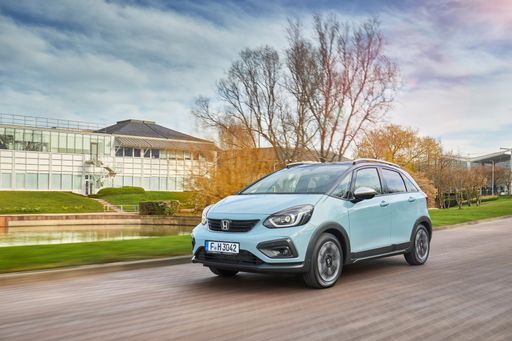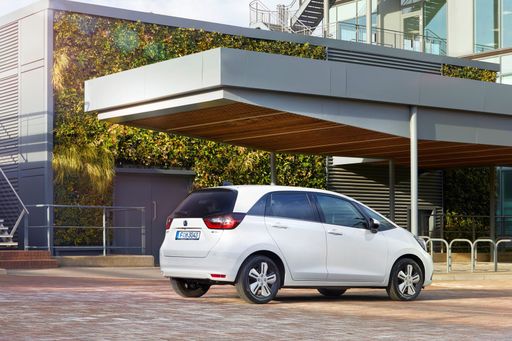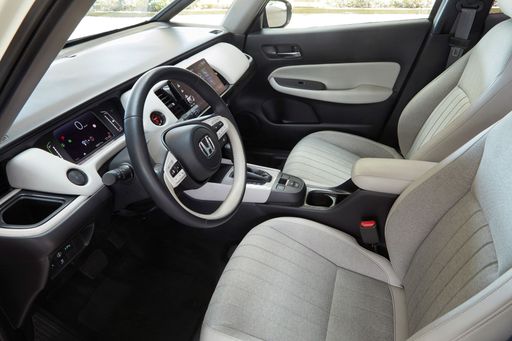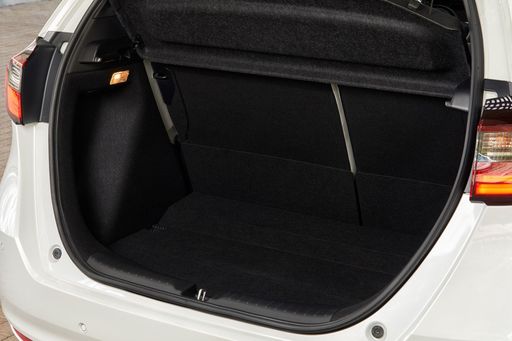Vauxhall Rocks Electric vs Honda Jazz – Differences & prices compared
Compare performance, boot space, consumption and price in one view.
Find out now: which car is the better choice for you – Vauxhall Rocks Electric or Honda Jazz?
The Vauxhall Rocks Electric (Hatchback) comes with a Electric engine and Automatic transmission. In comparison, the Honda Jazz (Hatchback) features a Full Hybrid engine with Automatic transmission.
When it comes to boot capacity, the Vauxhall Rocks Electric offers 63 L, while the Honda Jazz provides 304 L – depending on how much space you need. If you’re looking for more power, decide whether the 8 HP of the Vauxhall Rocks Electric or the 122 HP of the Honda Jazz suits your needs better.
In terms of consumption, the values are per 100 km for the Vauxhall Rocks Electric, and 4.50 L for the Honda Jazz.
Price-wise, the Vauxhall Rocks Electric starts at 6800 £, while the Honda Jazz is available from 23100 £. Compare all the details and find out which model fits your lifestyle best!
Vauxhall Rocks Electric
The Opel Rocks Electric stands out as a stylish and compact solution for urban mobility, offering both convenience and an eco-friendly commute. Its sleek design and vibrant colour options make it an attractive choice for those looking to navigate city streets with ease. This nimble vehicle not only promises a smooth ride but also enhances the overall urban driving experience.
detailsHonda Jazz
The Honda Jazz stands out in the compact car category with its intelligently designed interior, offering a surprisingly spacious cabin that comfortably accommodates passengers and luggage. Its efficient hybrid powertrain ensures a smooth and economical driving experience, ideal for both urban commutes and longer journeys. Furthermore, the Jazz is equipped with a range of advanced safety features, providing peace of mind while on the road.
details @ hondanews.eu
@ hondanews.eu
 @ hondanews.eu
@ hondanews.eu
 @ hondanews.eu
@ hondanews.eu
 @ hondanews.eu
@ hondanews.eu
 @ hondanews.eu
@ hondanews.eu

|
|
|
|
|
Costs and Consumption |
|
|---|---|
|
Price
6800 - 7500 £
|
Price
23100 - 26700 £
|
|
Consumption L/100km
-
|
Consumption L/100km
4.5 - 4.8 L
|
|
Consumption kWh/100km
-
|
Consumption kWh/100km
-
|
|
Electric Range
75 km
|
Electric Range
-
|
|
Battery Capacity
5.40 kWh
|
Battery Capacity
-
|
|
co2
0 g/km
|
co2
102 - 108 g/km
|
|
Fuel tank capacity
-
|
Fuel tank capacity
40 L
|
Dimensions and Body |
|
|---|---|
|
Body Type
Hatchback
|
Body Type
Hatchback
|
|
Seats
2
|
Seats
5
|
|
Doors
2
|
Doors
5
|
|
Curb weight
558 kg
|
Curb weight
1302 - 1320 kg
|
|
Trunk capacity
63 L
|
Trunk capacity
304 L
|
|
Length
2410 mm
|
Length
4089 - 4105 mm
|
|
Width
1388 mm
|
Width
-
|
|
Height
1525 mm
|
Height
1526 - 1556 mm
|
|
Payload
142 kg
|
Payload
370 - 388 kg
|
Engine and Performance |
|
|---|---|
|
Engine Type
Electric
|
Engine Type
Full Hybrid
|
|
Transmission
Automatic
|
Transmission
Automatic
|
|
Transmission Detail
Reduction Gearbox
|
Transmission Detail
-
|
|
Drive Type
Front-Wheel Drive
|
Drive Type
Front-Wheel Drive
|
|
Power HP
8 HP
|
Power HP
122 HP
|
|
Acceleration 0-100km/h
-
|
Acceleration 0-100km/h
9.4 - 9.7 s
|
|
Max Speed
45 km/h
|
Max Speed
175 km/h
|
|
Torque
40 Nm
|
Torque
253 Nm
|
|
Number of Cylinders
-
|
Number of Cylinders
4
|
|
Power kW
6 kW
|
Power kW
90 kW
|
|
Engine capacity
-
|
Engine capacity
1498 cm3
|
General |
|
|---|---|
|
Model Year
2025
|
Model Year
2023
|
|
CO2 Efficiency Class
A
|
CO2 Efficiency Class
C
|
|
Brand
Vauxhall
|
Brand
Honda
|
Vauxhall Rocks Electric
Introducing the Opel Rocks Electric
The world of electric mobility continues to expand with innovative vehicles, and the Opel Rocks Electric is at the forefront of this evolution. Embracing a sustainable future, this compact urban mobility solution combines distinctive styling with practical features, appealing particularly to city dwellers seeking an efficient and environmentally friendly mode of transportation.
Distinctive Design and Dimensions
Measuring just 2410 mm in length, 1390 mm in width, and 1520 mm in height, the Opel Rocks Electric boasts a compact design that makes navigating through narrow city streets a breeze. Despite its diminutive size, it offers a surprising amount of space with a clever two-seater configuration. The vehicle’s quirky and modern appearance clearly distinguishes it from conventional cars, while the available Klub and Tekno trims tailor its aesthetic to match individual preferences.
Technical Brilliance of Electric Power
Under the hood, the Opel Rocks Electric prioritises eco-friendliness with a completely electric powertrain. The battery capacity of 5.4 kWh powers an 8 PS (6 kW) motor, which delivers a maximum torque of 40 Nm. This configuration is ideal for urban environments, providing sufficient punch for everyday city commutes while maintaining energy efficiency.
Range and Efficiency
The vehicle’s electric range is rated at 75 km on a full charge, making it perfect for short daily trips or running errands around the city. With a top speed restricted to 45 km/h, this car falls into the light four-wheeler category, granting road use eligibility for certain groups, such as young drivers.
Comfort and Practicality
The innovative design extends beyond functionality to include comfort and convenience. The two-seat configuration offers ample space for driver and passenger, and with a boot capacity of 63 litres, there’s room for essentials and shopping bags. Additionally, its lightweight architecture, with a kerb weight of 471 kg, enhances efficiency and agility.
Safety and Sustainability
The Opel Rocks Electric’s commitment to sustainability and safety is evident in its design and operation. It achieves a commendable CO2 efficiency class of A and produces zero emissions, aligning with global efforts to combat climate change. This electric mobility solution is as kind to the planet as it is to the wallet, with an attractive price range of €8,340 - €9,140.
Conclusion
The Opel Rocks Electric represents a bold step forward in urban transportation, blending sustainable technology with convenience. For those seeking an eco-friendly, efficient, and stylish way to move around the city, this electric car is an excellent choice, reflecting Opel's dedication to innovation in mobility.
Honda Jazz
The Evolution of the Honda Jazz: A Modern Marvel in Compact Design
The Honda Jazz, known for its compact yet spacious design, continues to impress with its blend of practicality and innovation. Today, we delve into the technical details and innovations that make the latest models of the Honda Jazz stand out in the competitive auto market.
Hybrid Powertrain: Efficiency and Performance
The Honda Jazz is equipped with a cutting-edge 1.5 i-MMD e:HEV full hybrid engine, delivering an impressive 122 PS, or 90 kW. This powertrain seamlessly balances efficiency and performance, achieving a fuel consumption of 4.5 to 4.8 L/100km. Whether navigating the city streets or taking on longer journeys, the Jazz provides a responsive and smooth driving experience, accentuated by its CVT automatic transmission.
Sleek Design with Smart Storage Solutions
Staying true to its roots, the Honda Jazz maintains a compact exterior with dimensions ranging from 4089 to 4105 mm in length and 1526 to 1556 mm in height. Despite its size, the Jazz offers ample luggage capacity of 304 litres, thanks to the intelligent Magic Seat system that allows for flexible storage configurations. The combination of a sleek design with practical storage makes the Jazz an ideal city companion.
Advanced Technology and Comfort
The Honda Jazz doesn’t stop at efficiency; it also comes packed with a plethora of technological features. As part of its high-tech package, the Jazz includes a state-of-the-art infotainment system and various driving assistance technologies, enhancing both safety and comfort. Families and commuters alike will appreciate the thoughtfully designed interior, seating up to five passengers with ease.
Performance and Handling Dynamics
The driving experience of the Honda Jazz is primarily characterised by its lively handling and assured grip thanks to its front-wheel-drive configuration. With a torque of 253 Nm and a 0-100 km/h acceleration between 9.4 to 9.7 seconds, the Jazz offers adequate performance for everyday urban driving. The maximum speed reaches 175 km/h, ensuring the Jazz can hold its own on motorways too.
Environmental Responsibility and Cost Efficiency
In an era of heightened environmental awareness, the Honda Jazz stands out with a CO2 emission range of 102 to 108 g/km, adhering to the CO2 Efficiency Class C. Cost-conscious consumers will appreciate the Jazz's low running costs, with potential expenses ranging from €812 to €877 per month and a cost per kilometre of 32.5 to 35.1 cents.
Conclusion: A Comprehensive Package
Combining innovation, economy, and style, the Honda Jazz serves as a testament to Honda's commitment to evolving their compact range to meet the modern driver's needs. For those seeking a reliable, efficient, and technologically advanced vehicle, the Honda Jazz stands ready to elevate their driving experience.
The prices and data displayed are estimates based on German list prices and may vary by country. This information is not legally binding.
